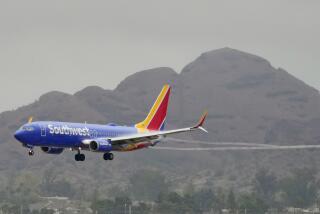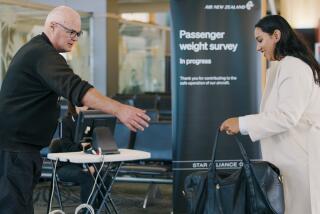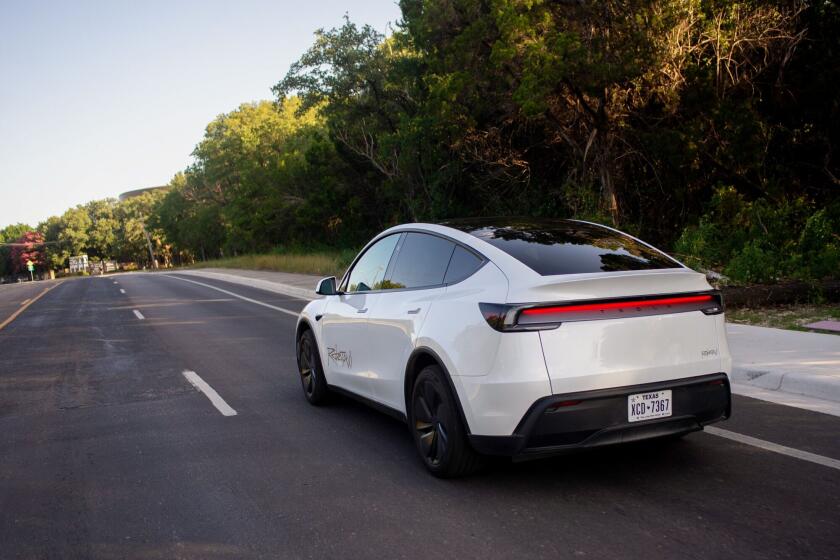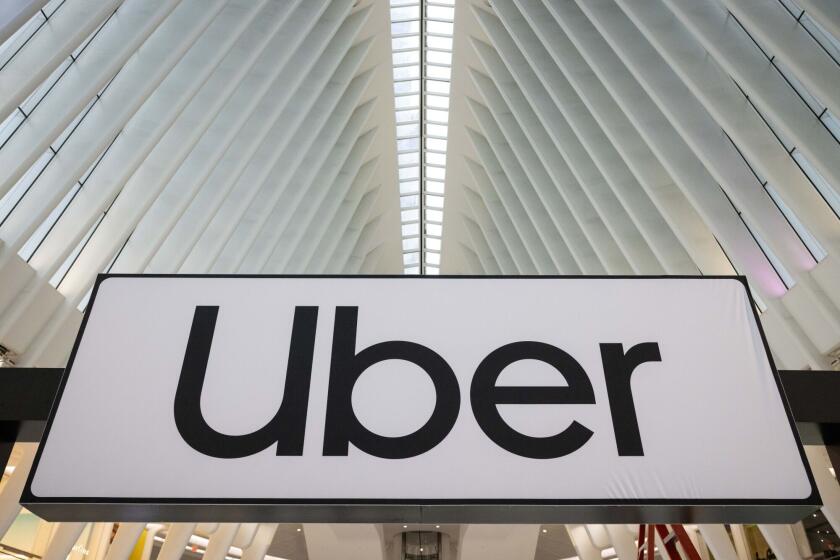Carrier’s green ways show in air, on ground
- Share via
AUCKLAND, NEW ZEALAND — Thousands of Southern Californians fly to this remote country every year to check the vast stretches of unspoiled mountainous and coastal beauty made famous by the epic “Lord of the Rings” trilogy.
But even to repeat travelers here, it may be a surprise that this small nation’s biggest airline is on a mission to be the cleanest, most fuel-stingy and perhaps the quirkiest airline flying in the world.
Air New Zealand Ltd.’s slogan: “We’re changing the way you fly.” And it seems to mean it.
In recent months, the airline made headlines with several fuel-saving and environmentally conscious initiatives including demonstrating a new way of flying an airplane and testing the use of a weed as a source of jet fuel.
The innovative moves, which are being closely watched by the aviation industry, have put the airline at the forefront of finding new ways of cutting back on fuel use and harmful carbon emissions. Last year, the carrier even hired the head of Greenpeace International in New Zealand to coordinate the environmental initiatives.
New Zealand is indeed a bit out of the way -- a 12-hour flight across a vast expanse of the Pacific from Los Angeles -- but that is perhaps why the airline has been trying so hard to stand out.
This month, the airline will launch an unusual marketing campaign in Los Angeles in which it will pay 30 people to shave their heads and serve as “cranial billboards.” Playing off the financial crisis, the shaved heads will have temporary, two-week tattoos that will read: “Need a Change? Head Down to New Zealand.” Those selected in a casting call will be offered a free round-trip ticket to New Zealand or an unspecified amount of cash.
“Gas prices, the economy, the bank situation, the housing market and the dynamic election are leaving many Californians with a need for change,” said Roger Poulton, the airline’s vice president in charge of North America. “What better way to illustrate a dramatic transformation than to shave one’s head?”
In a first among Pacific carriers, Air New Zealand has begun installing electric blow dryers in the ceiling of its planes. The dryers cut down on cabin condensation that can weigh down an aircraft with more than 440 pounds of water.
In many ways, these efforts reflect the country’s obsession with maintaining a clean landscape and the airline’s quirky culture, which is clearly visible at the headquarters here.
Don’t look for a mahogany paneled board room with plush leather chairs.
When Air New Zealand’s top executives hold high-level corporate meetings, they sit on puffy bean bags thrown haphazardly on the middle of the floor in front of a wall plastered with pictures of their family and friends.
“We’re a bit more egalitarian than others,” said Rob Fyfe, the chief executive of New Zealand’s flagship carrier, who gave up commuting to work on a Vespa scooter after company directors raised concerns about possibly losing their top executive in a traffic accident.
The carrier is focused on environmental issues, perhaps more than any other airline, because it is part of its country’s image, said Richard Aboulafia, an analyst at Fairfax, Va.-based aviation research and consulting firm Teal Group Corp. Preserving the environment is “part of their business promotion and brand, and they’ve been very successful at it.”
The airline operates six long-haul flights a day at Los Angeles International Airport using Boeing’s 747 and 777 jumbo jets that are often packed with American tourists.
In the last fiscal year that ended June 30, about 2.5 million foreign tourists traveled to the country, up 6% from the previous year. The country, which encompasses two islands about 1,200 miles southeast of Australia, is home to only about 4 million residents, or about the same population as Los Angeles.
(The airline is also a favorite of Hollywood celebrities who travel from LAX to London -- a little-known service route that the airline has tried to keep under wraps as a way to help shield its high-profile passengers from prying photographers and fanatic fans. Although other airlines tout their celebrity passengers, Air New Zealand has refused to divulge any names or acknowledge that Hollywood personalities often fly the airline. “We really don’t like to talk about that,” said Mike Tod, the airline’s spokesman.)
Despite high fuel costs that have hammered the air-travel industry with billions of dollars in losses, the airline is one of the few carriers that has managed to post a large profit.
Fyfe said he expected the carrier to remain profitable if the price of jet fuel remained below $140 a barrel. Prices for fuel have fallen to an average of about $115 a barrel this week.
“We believe we will emerge from this economic cycle in an even stronger competitive position,” Fyfe said. But he also cautioned that a global economic downturn could weigh on profit as even well-heeled travelers begin cutting back on spending.
The environmental efforts go hand in hand with a company culture that shuns hierarchy and promotes innovation. Fyfe and senior executives, most of them in their late 30s and early 40s, switch jobs with the rank and file for a few days every month. He has worked the aisles as a flight attendant, handled baggage and worked the check-in counter.
Fyfe works behind a desk that is visible from anyone on the floor, which is covered with recycled carpet and wood trims made from trees that came from a sustainable forest.
The five-story office building, which employees like to call “the Hub,” is made mostly of glass that allows as much sunlight in as possible to cut down on electric use. There are no cubicle walls to darken the rooms, and lights automatically turn off at 6 p.m. and turn back on at 7:30 a.m. Sensors that detect human movement will turn on the lights but then shut them down if there is no activity for 15 minutes.
Last year, the airline hired the former executive director of New Zealand’s branch of Greenpeace International, one of the world’s largest and most aggressive environmental organizations, to coordinate the company’s various in-house efforts to reduce energy use by 5% every year. They include company bicycles that employees can use to commute to work or to do errands during lunch breaks.
“We grew up thinking this is one of the greatest places on Earth, and we want do our part to preserve it,” said Tod, the airline’s spokesman and a native Kiwi.
A few weeks ago, the carrier operated a plane from Auckland to San Francisco to demonstrate how a flight could save thousands of gallons of fuel and cut tons of carbon emissions by using new technology and procedures it had developed with the U.S. Federal Aviation Administration.
Sometime before the end of the year, the airline plans to fly a Boeing 747 partially powered by jet fuel refined from the seed of the fast-growing jatropha weed plant. It would be part of the airline’s move to find alternatives to fossil fuel that are not harmful to the environment. It hopes to use so-called biofuels, which could also include fuel refined from algae, for about 10% of its needs by 2013.
“For an isolated island destination such as ours, air travel is critical,” Fyfe said, adding that 70% of its passengers are tourists attracted by the country’s clean waters, beaches and rivers. “It’s important for Air New Zealand to be seen operating an airline consistent with what motivates people to come and visit New Zealand.”
--
More to Read
Inside the business of entertainment
The Wide Shot brings you news, analysis and insights on everything from streaming wars to production — and what it all means for the future.
You may occasionally receive promotional content from the Los Angeles Times.










